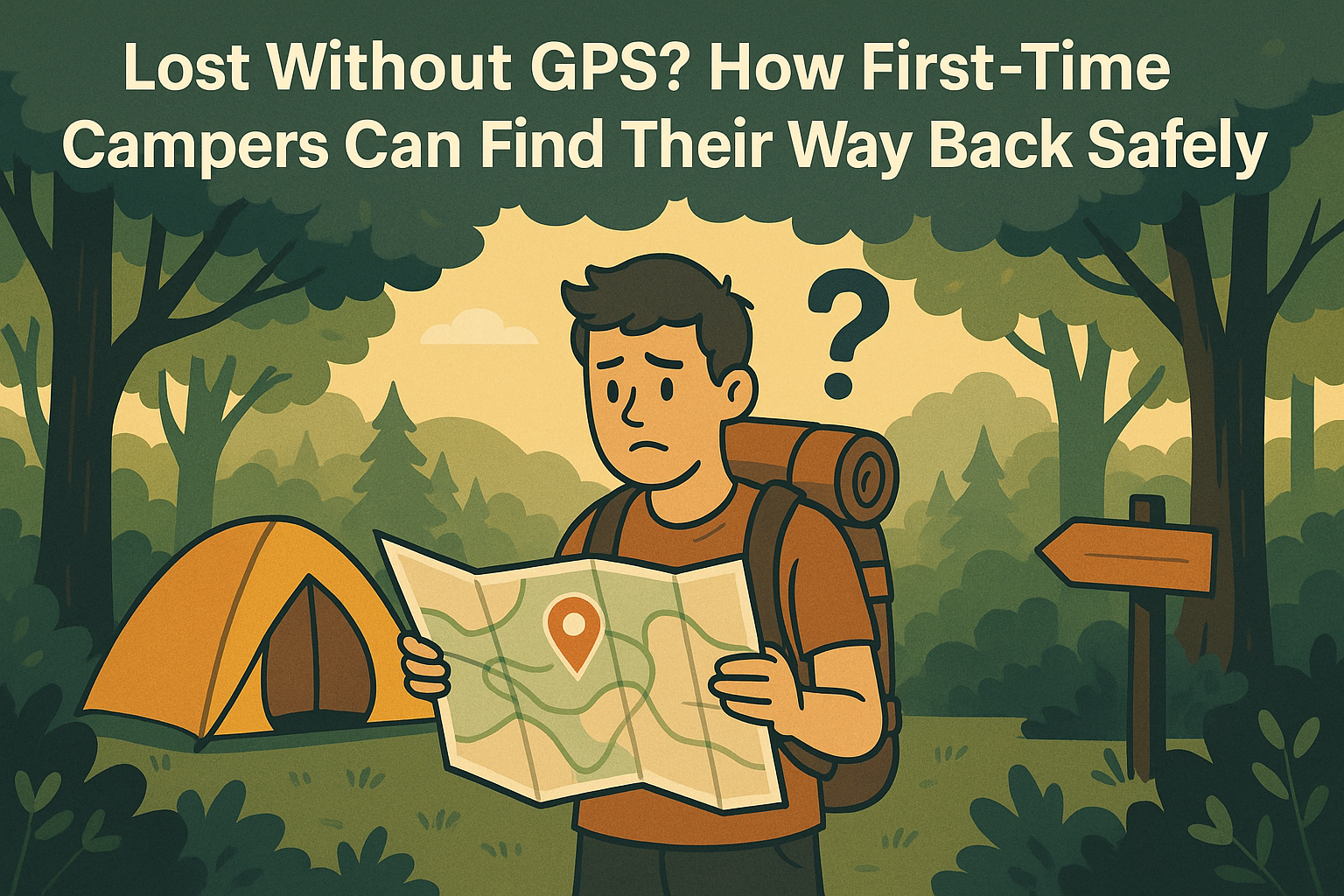You step off the trail for just a moment —
Maybe you went to find firewood. Maybe you chased a sound.
Minutes turn into hours.
You check your phone.
No signal. No GPS. No idea where you are.
Panic sets in.
But here’s the truth:
Getting lost doesn’t kill you. Panicking does.
If you know just a few smart tricks — you can find your way back safely.
Here’s how to survive getting lost without GPS — even if it’s your first camping trip ever.
1. The “Reverse Tracking” Method: Find Your Own Footprints Back
You don’t need a compass.
You already left a trail: your feet.
What to do immediately:
- Stop moving. Take a slow 360° scan of the ground around you.
- Look for ground disturbance:
- Crushed grass
- Broken twigs
- Scuffed dirt
- Muddy prints
- Walk backward along your own track — literally backtracking yourself.
Why it works:
You leave more disturbance leaving than you notice — and it points back to your last known trail.
Micro-Tip:
- Move backward step by step the way you came if the trail is faint.
- Mark each step you backtrack by stacking small rocks or making a symbol in the dirt (to avoid looping).
Your own footprints are your first rescue map.
2. The “Shadow Stick” Trick to Create a Compass (Without a Compass)
This isn’t folklore — it’s a proven survival method.
Here’s how:
- Stick a straight stick vertically into the ground.
- Mark where the tip of its shadow falls with a rock.
- Wait 15–20 minutes.
- Mark the new position of the shadow tip.
- Draw a line between the two marks — that’s approximately east-west.
Knowing east-west gives you basic directional orientation — even if you don’t know your full location.
Field Hack:
If you remember roughly where your camp or trail was (e.g., “south of the river”), this rough compass is enough to align yourself back.
Even a stick and patience can give you the world’s oldest GPS.
3. The “Handrail” Trick: Follow Natural Boundaries
Professional search-and-rescue teams use a method called “handrailing” — and you can too.
Here’s how:
- Find a natural boundary near you:
- A river
- A ridge line
- A cliff edge
- A clear treeline boundary
- Follow it in one consistent direction.
(Example: walk along the river downstream.)
Why it works:
Most human trails, camps, and roads are built near natural boundaries — rivers, valleys, low ground.
If you “rail” yourself along a river or ridge line, you massively increase your odds of intersecting a trail, road, or help.
Key survival rule:
Pick one boundary. Stick to it. Don’t zigzag.
4. The “Sun Arc Mapping” Trick to Stay Oriented (Even In Motion)
Even without a perfect compass, the sun’s movement gives you directional orientation — if you use it right.
Real survival method:
- Early Morning (sun rises): East.
- Noon: Sun is roughly south (Northern Hemisphere).
- Evening (sun sets): West.
Simple Field Hack:
- Hold out your left arm toward where the sun rises (morning) → that’s east.
- Your right arm automatically points west.
- Front = north.
- Back = south.
As you walk, keep checking the sun’s position every 30 minutes to avoid unintentionally turning in circles.
The sun isn’t just light — it’s your silent guide.
5. Mark Your Path Forward — Always
Even while lost, leave yourself a trail.
Here’s how:
- Stack small rocks at eye level.
- Break small branches and point them in the direction you’re moving.
- Mark large trees with scratches (if survival is at stake).
Why this matters:
- You create a “breadcrumb” trail you can retreat along if your chosen direction fails.
- Rescuers can also track your path if needed.
Field Tip:
Every 30–50 steps, make a visible mark — in survival, not marking your movement is suicidal.
6. Use the “Height Seek” Strategy for Visibility
Big mistake most lost campers make:
Wandering low where they can’t see anything.
Instead:
- Find the highest nearby safe elevation — small hill, large rock, gentle slope.
- Climb carefully.
- Survey the area:
- Look for roads.
- Look for rivers.
- Look for straight lines (roads and trails rarely curve wildly in forests).
Why?
Straight lines = manmade.
Follow any visible road, power line, or fencing line toward civilization.
Safety Tip:
Don’t climb dangerous steep cliffs just for visibility — if you fall, no one will find you at all.
Height isn’t just for signal — it’s for planning escape.
7. If All Else Fails: The “S.T.O.P. and Survive” Protocol
If moving seems too risky — stop and get rescued smartly.
S.T.O.P. =
- S: Stop moving. Conserve energy.
- T: Think logically. No panic decisions.
- O: Observe surroundings. Weather? Hazards? Resources?
- P: Plan. Set up high-visibility signals (bright gear, rocks forming SOS, fires with smoke during day if safe).
High Visibility Rescue Hacks:
- Spread bright gear wide apart (tarp, clothes, backpack).
- Create geometric patterns (triangles, X shapes — natural shapes are rare, human patterns stand out).
- If possible, signal at regular times — searchers scan systematically.
Survival Stat:
- 80% of lost hikers are found within 24–48 hours if they stay put and signal intelligently.
In survival, smart visibility saves lives faster than blind wandering.
🏕 Conclusion: You Can Find Your Way Back Without GPS
Getting lost is terrifying —
but getting smart saves your life.
- Follow your footprints.
- Build your own compass.
- Handrail nature’s pathways.
- Mark your trail.
- Seek height wisely.
- And if needed, STOP and survive smart.
Solo camping isn’t just about finding peace — it’s about finding your own survival instincts.
And after surviving your first real wilderness test —
you’ll carry a quiet confidence the GPS generation can’t even imagine.

